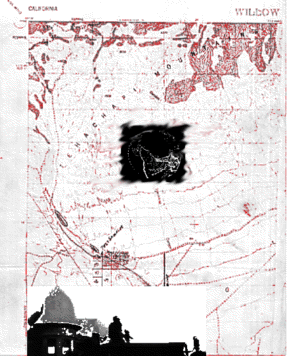THE LOST MINE 3
A miner would arrive in Tehachepi with an account of the accidental discovery, a horn spoon, and a pocketful of quartzite. He'd stake a claim. Find a partner. They would work it, a few hundred feet of drift tunnels, even, under miserable conditions. And then the vein would disappear in a blank wall. A compressed schist. A roll of rock from the earth turning over in her sleep. Surely the vein continued elsewhere, but where? And then the tunnels would fill with water. In the papers, a report would note that another partnership had been "prospecting without success." Or sometimes the mine would never make the papers; the miners would keep the discovery quiet for months, and in their failure to persuade the gold from the earth, quiet forever.
The Alcor would have been one such mine. It was reputedly "discovered" by an Indian searching for a lost burro; he grabbed up a rock to scare the burro out of a ravine, and found he had a handful of gold-bearing quartzite. He'd worked on roads to other mines, so he knew what this might be worth.
The original claim in 1873 listed Christian Beveridge as owner. A new claim was granted to a Vasquez-Quicksilver partnership in 1878, but the ownership remained in dispute. Beale and Vineyard claimed it, in 1881, as existing within the new boundaries of the Tejon Ranch.
What Beale and Vineyard did not know, but had the money and guts to find out, was where the gold veins reappeared in the fractured faults. George knew the map showed the crossing points of the faults--but if he couldn't find the locations on the real ground for Beale and Vineyard, he was useless. If he could find the crossroads, he was a threat, and just as dead. It is the pattern, the loop of stars and railroads and cracks in the earth.


